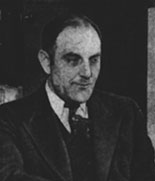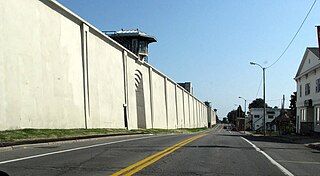
Victor Lustig was a con artist from Austria-Hungary, who undertook a criminal career that involved conducting scams across Europe and the United States during the early 20th century. Lustig is widely regarded as one of the most notorious con artists of his time, and is infamous for being "the man who sold the Eiffel Tower twice" and for conducting the "Rumanian Box" scam.

Sing Sing Correctional Facility is a maximum-security prison for men operated by the New York State Department of Corrections and Community Supervision in the village of Ossining, New York, United States. It is about 30 miles (48 km) north of Midtown Manhattan on the east bank of the Hudson River. It holds about 1,700 inmates as of 2007, and housed the execution chamber for the State of New York for a period, with the final execution there occurring in 1963; instead Green Haven Correctional Facility had the execution chamber by the late 20th Century. The total abolition of capital punishment in New York occurred in 2007.

Calvert Vaux FAIA was an English-American architect and landscape designer. He and his protégé Frederick Law Olmsted designed parks such as Central Park and Prospect Park in New York City and the Delaware Park–Front Park System in Buffalo, New York.

Louis Jay Pearlman was an American music manager and scam artist. He was the person behind many successful 1990s boy bands, having formed and funded the Backstreet Boys. After their massive success, he then developed NSYNC.

Charles "Carl" Panzram was an American serial killer, spree killer, mass murderer, rapist, child molester, arsonist, robber, thief and burglar. In prison confessions and in his autobiography, Panzram confessed to having murdered twenty-one boys and men, only five of which could be corroborated; he is suspected of having killed more than a hundred boys and men in the United States alone, and several more in Portuguese Angola.

Clinton Correctional Facility is a New York State Department of Corrections and Community Supervision maximum security state prison for men located in the Village of Dannemora, New York. The prison is sometimes colloquially referred to as Dannemora, although its name is derived from its location in Clinton County, New York. The southern perimeter wall of the prison borders New York State Route 374. Church of St. Dismas, the Good Thief, a church built by inmates, is located within the walls. The prison is sometimes referred to as New York's Little Siberia, due to the cold winters in Dannemora and the isolation of the upstate area. It is the largest maximum-security prison and the third-oldest prison in New York. The staff includes about 1,000 officers and supervisors.
The official title of "state electrician" was given to some American state executioners in states using the electric chair during the early 20th century, including the New York State electrician. The title itself is somewhat of a euphemism, while the persons appointed were electricians by trade, the title on its own did not give any indication as to the true responsibilities of the position.
Auburn Correctional Facility is a state prison on State Street in Auburn, New York, United States. It was built on land that was once a Cayuga village. It is classified as a maximum security facility.
The Colombo crime family is an Italian-American Mafia crime family and the youngest of the "Five Families" that dominate organized crime activities in New York City within the criminal organization known as the American Mafia. It was during Lucky Luciano's organization of the American Mafia after the Castellammarese War, following the assassinations of "Joe the Boss" Masseria and Salvatore Maranzano, that the gang run by Joseph Profaci became recognized as the Profaci crime family.
Steven Jay Russell is an American con artist, known for escaping from prison multiple times.
Green Haven Correctional Facility is a maximum security prison in New York, United States. The prison is located in the Town of Beekman in Dutchess County. The New York State Department of Corrections and Community Supervision lists the address as Route 216, Stormville, New York 12582. This prison housed New York's execution chamber during the time the state briefly had the death penalty in the post-Furman era. It was originally a federal prison and now houses maximum security inmates. Green Haven Correctional Facility also operated a Hot Kosher Foods Program; but no longer does as of 2020. However, because of this, the prison had a large Jewish population. Yale Law School operates the Green Haven Prison Project, a series of seminars among Yale law students and Green Haven inmates on law and policy issues concerning prisons and criminal law.
William McCloundy, also known as I.O.U. O'Brien, was an early 20th-century confidence trickster, from Asbury Park, New Jersey, who served a two-and-a-half-year prison term in Sing Sing for "selling" the Brooklyn Bridge to a tourist in 1901.

20,000 Years in Sing Sing is a 1932 American pre-Code drama film set in Sing Sing Penitentiary, the maximum security prison in Ossining, New York, starring Spencer Tracy as an inmate and Bette Davis as his girlfriend. It was directed by Michael Curtiz and based on the nonfiction book Twenty Thousand Years in Sing Sing written by Lewis E. Lawes, the warden of Sing Sing from 1920 to 1941.

Two Smart People is a 1946 American film noir crime drama film directed by Jules Dassin and starring Lucille Ball, John Hodiak, Lloyd Nolan and Hugo Haas. It was produced by Metro-Goldwyn-Mayer. It was one of a number of noirs starring Hodiak.

Swampland in Florida is a figure of speech referring to real estate scams in which a seller misrepresents unusable swampland as developable property. These types of unseen property scams became widely known in the United States in the 20th century, and the phrase is often used metaphorically for any scam that misrepresents what is being sold. Expressions like "If you believe that, then I have swampland in Florida to sell you", suggests the recipient is gullible enough to fall for an obvious fraud. Similar phrases involve "selling" the Brooklyn Bridge or nonexistent "oceanfront property in Arizona".
Daniel Pagano is a New York mobster and street boss in the Genovese crime family who was involved in a famous gasoline bootlegging racket of the 1980s.
Reed C. Waddell was an American swindler, confidence man and underworld figure in New York during the mid- to late 19th century. He was one of the most successful men of his trade making nearly a quarter of a million dollars using his "gold brick" swindle, a con game which he invented and introduced to New York in 1880, and from which the term "goldbricker" originated.

The Federal Correctional Institution, La Tuna is a low-security United States federal prison for male inmates in Anthony, Texas. It is operated by the Federal Bureau of Prisons, a division of the United States Department of Justice. A satellite prison camp, located adjacent to the facility, houses minimum-security inmates.











